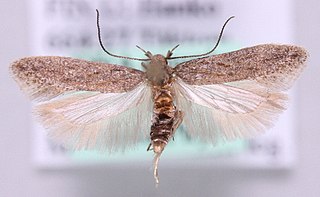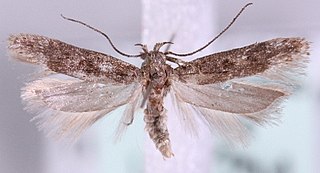Scrobipalpa indignella is a moth of the family Gelechiidae. It is found in southern Russia, Ukraine and from the Near East and Middle East to Afghanistan and China (Xinjiang).

Scrobipalpa nitentella, the common sea groundling, is a moth of the family Gelechiidae. It is found in most of Europe, North Africa (Tunisia), Turkey, Afghanistan, Kazakhstan, China, Mongolia and Siberia (Transbaikalia).

Scrobipalpa salinella, the sea-aster groundling, is a moth of the family Gelechiidae. It is found Europe, along the coast and in inland halophytic habitats. In the east, the range extends through Siberia and Central Asia to Mongolia. It is also found in North Africa.

Scrobipalpa samadensis, the buck's-horn groundling, is a moth of the family Gelechiidae. It is found in most of Europe and Russia.
Scrobipalpa albostriata is a moth in the family Gelechiidae. It was described by Povolný in 1977. It is found in northern Iran.
Scrobipalpa superstes is a moth in the family Gelechiidae. It was described by Povolný in 1977. It is found in southern Spain, Portugal, southern France and on Sardinia and Sicily.
Scrobipalpa abai is a moth in the family Gelechiidae. It was described by Povolný in 1977. It is found in Afghanistan.
Scrobipalpa albofusca is a moth in the family Gelechiidae. It was described by Povolný in 1971. It is found in Algeria.
Scrobipalpa forsteri is a moth in the family Gelechiidae. It was described by Povolný in 1971. It is found in Tunisia.
Scrobipalpa nana is a moth in the family Gelechiidae. It was described by Povolný in 1973. It is found in Turkey, northern Iran, Kazakhstan and the southern Ural Mountains.
Scrobipalpa argenteonigra is a moth in the family Gelechiidae. It was described by Povolný in 1972. It is found in northern Iran.
Scrobipalpa audax is a moth in the family Gelechiidae. It was described by Povolný in 1966. It is found in Algeria.
Scrobipalpa confusa is a moth in the family Gelechiidae. It was described by Povolný in 1966. It is found in Syria.
Scrobipalpa planodes is a moth in the family Gelechiidae. It was described by Edward Meyrick in 1918. It is found in southern India.
Scrobipalpa atriplex is a moth in the family Gelechiidae. It was described by August Busck in 1910. It is found in North America, where it has been recorded from California.
Scrobipalpa jariorum is a moth in the family Gelechiidae. It was described by Peter Huemer and Ole Karsholt in 2010. It is found in Bulgaria.
Scrobipalpa montanella is a moth in the family Gelechiidae. It was described by Pierre Chrétien in 1910. It is found in southern France and Sicily.
Scrobipalpa omachella is a moth in the family Gelechiidae. It was described by Charles Oberthür in 1888. It is found in North Africa.
Scrobipalpa spergulariella is a moth in the family Gelechiidae. It was described by Pierre Chrétien in 1910. It is found in Tunisia, Spain, southern France, on Sicily, in Greece and on Crete.
Scrobipalpa septentrionalis is a species of moth native to northern China. It was one of nine Chinese species described by Oleksiy Bidzilya and Houhun Li in 2019. In coloration, it is mostly gray and brown, with some white on the head and antennae. Its wingspan is 11.0–13.5 millimetres (0.43–0.53 in). The plant on which it breeds is unknown.


